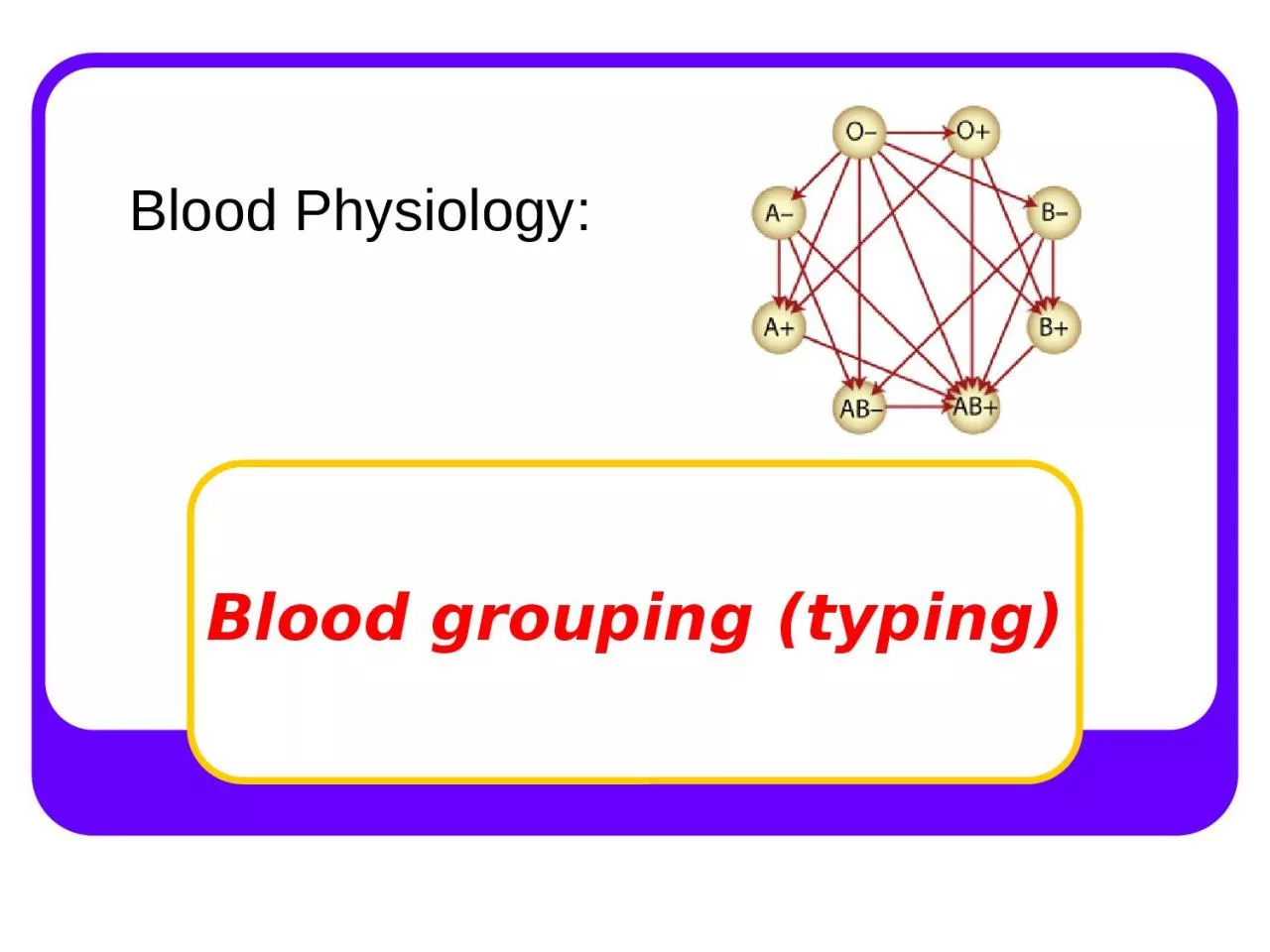

Purpose The purpose of this lab is to help you to understand the ABO blood group system and its importance in blood transfusion Background The current system of blood grouping was discovered by Landsteiner in 1900 and is known as the Landsteiners ABO system ID: 1032045
Download Presentation The PPT/PDF document "Blood grouping (typing) Blood Physiology..." is the property of its rightful owner. Permission is granted to download and print the materials on this web site for personal, non-commercial use only, and to display it on your personal computer provided you do not modify the materials and that you retain all copyright notices contained in the materials. By downloading content from our website, you accept the terms of this agreement.
1. Blood grouping (typing)Blood Physiology:
2. PurposeThe purpose of this lab is to help you to understand the ABO blood group system, and its importance in blood transfusion.
3. BackgroundThe current system of blood grouping was discovered by Landsteiner in 1900 and is known as the Landsteiner's ABO system.
4. BackgroundWhen blood from one person is mixed with plasma from another person, the red blood cells will sometimes agglutinate or clump together. This agglutination, which is very important in determining the safety of transfusion (agglutinated cells can block small blood vessels), is due to a mismatch of genetically determined blood types.
5. BackgroundA blood group is determined by the presence or absence of specific antigens (proteins) on the surface of red blood cells (RBC). There are two different classes of antigens: the A and B antigens, in addition to the Rh antigens.
6. Background – ABO blood group systemBlood group A: If you have type A antigens on the surface of your RBCs, you also have anti-B antibodies in your plasma.
7. Background – ABO blood group systemBlood group B: If you have type B antigens on the surface of your RBCs, you also have anti-A antibodies in your plasma.
8. Background – ABO blood group systemBlood group AB: If you have type A and type B antigens on the surface of your RBCs, you do not have antibodies to A or B antigens in your plasma.
9. Background – ABO blood group systemBlood group O: If you have neither type A nor type B antigens on the surface of your RBCs, you have anti-A and anti-B antibodies in your plasma.
10. Background - Rh factorRhesus types: most people are "rhesus positive" as they have rhesus antigens on their red blood cells. But, about 3 in 20 people do not have rhesus antigens and are said to be "rhesus negative".
11. Background – NoteO blood type is called the UNIVERSAL DONOR because it has no ABO antigens for a patient's antibodies to attach.In contrast, AB blood type is called the UNIVERSAL RECIPIENT because it has no ABO antibodies to attach the antigens on transfused red blood cells.
12. Background – Rh disease of the newbornRh disease of the newborn may also be called erythroblastosis fetalis and is the result of an Rh incompatibility between mother and fetus. If the mother is rhesus negative, and the newborn baby is rhesus positive, then the mother's immune system may produce anti-rhesus antibodies. These may attach and destroy the baby's blood cells and this condition is called hemolytic disease of the newborn.
13. Background – Blood groups and pregnancyThis is rarely a problem in a first pregnancy. However, without treatment, this can become a serious problem in subsequent pregnancies. If an Rh-negative woman delivers an Rh-positive baby, she should be given Rho-GAM within 72 hours after delivery.
14. Background – Blood groups and pregnancyRho-GAM is an anti-Rh antibody that will destroy any fetal RBCs that have entered the mother’s circulation before her immune system can respond and produce antibodies.
15. ProcedureObtain a clean slide, a Hema-tag (with circles), and 3 toothpicks.Dangle the hand down to increase the flow of blood in the fingers.Clean the fingertip with 70% alcohol (usually ring or middle finger).With the help of the sterile lancet, pierce the fingertip and place one drop of blood in each of the cavities.
16. ProcedureAdd one drop of antiserum into each cavity as shown below:Mix each blood drop and the antiserum using a fresh mixing stick.Observe agglutination in the form of fine red granules within 30 seconds. Anti RhD takes slightly longer time to agglutinate compared to Anti A and Anti B.
17. Procedure - Observation and Result
18. Procedure - Observation and ResultTable: Determination of blood group and Rh factor based on agglutination seen